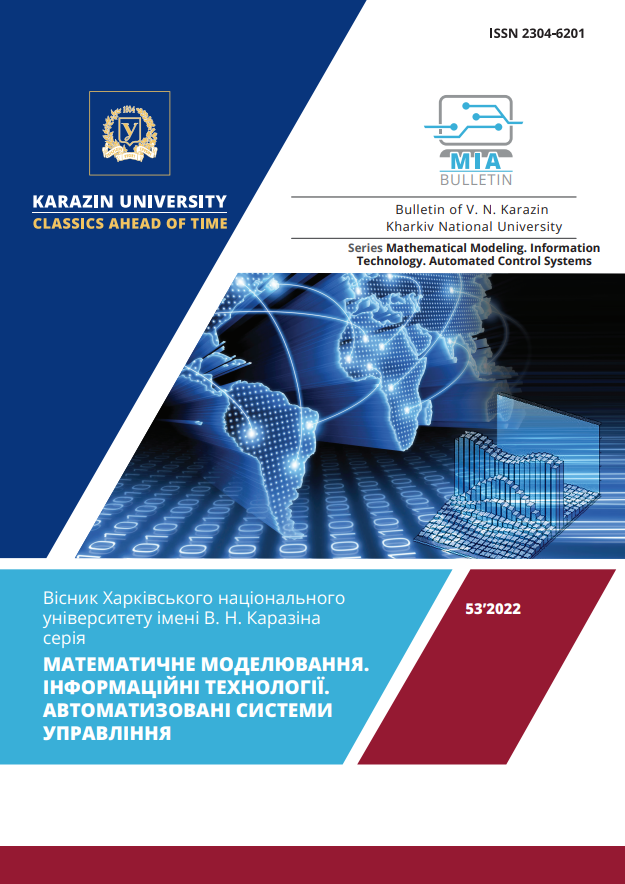Reseacrh of the possibilities of 3d-visualisation model of classrooms of the department
Abstract
It is difficult to imagine modern technologies without the 3D modeling and 3D visualization. The most important advantage of this technology is the possibility to create and inspect virtually 3D models of any objects which takes much less time than creating these objects physically. Therefore, this technology allows creating cartoons, films, virtual tours, and advertisements. Nowadays there are many programs for creating 3D models, which are constantly developed and updated. In this work the process of creating the 3D model of the V.N. Karazin University classrooms is described, which allows conducting virtual tours of the university. Blender, the free 3D computer graphics software tool has been used to develop the model. The main advantage of Blender over other programs is that, each user is able to create applications for this program. The development stages, namely, a concept phase, a 3D modeling, an application of textures and colors, lighting, and rendering are described. In order to understand the capabilities and functions of the created 3D-model, the methodology of functional modeling IDEF0 has been used. With the help of IDEF0 notation the scheme of 3D-model has been created. The processes of users’ interaction with 3D-model have been considered. The opportunities presented by the 3D model of classrooms have been investigated. The developed interactive 3D model is available to users on the university site. Users can choose an object or field of view, angle, and tilt angles. Users can also zoom in or out of the image. Thus, using the developed 3D model, users can learn about the classrooms and their interior. We are planning to increase the efficiency of the process of creating such 3D models by creating add-ons to Blender in Python language which allows automating the process of creating a 3D object. Their using can reduce the time needed to create 3D models of remaining classrooms, as well as, the number of developers required.
Downloads
References
/References
Andrew McDonald. A Beginners Guide to 3D, 2019. https://discover.therookies.co/2019/04/27/a-beginners-guide-to-3d/.
A. A. Prakhov. Tutorial Blender 2.7, 2016. [in Russian] https://books.google.com.ua/books/about/Blender_2_7.html?id=CEYpDQAAQBAJ&printsec=frontcover&source=kp_read_button&redir_esc=y#v=onepage&q&f=false.
Antti Konsén. 3D model of a real world model, 2015. https://www.theseus.fi/bitstream/handle/10024/103541/Konsen_Antti.pdf?sequence=1&isAllowed=y.
Megan Ashley Stephens. 3D Modeling Techniques for Print and Digital Media, 2015. https://core.ac.uk/download/pdf/232140462.pdf.
Siddhartha Chaudhuri. 3d modeling with data-driven suggestions, 2011. https://stacks.stanford.edu/file/druid:vq766tr8762/sid_thesis-augmented.pdf.
V.P.Bolshakov. Basics of 3D modeling. We study work in AutoCAD, KOMPAS-3D, SolidWorks, Inventor, 2012. [in Russian] https://books.google.com.ua/books?id=xmtiaDiwp4EC&pg=PA11&hl=ru&source=gbs_toc_r&cad=3#v=onepage&q&f=false.
Cheremnykh S.V., Semenov I.O., Ruchkin V.S. System modeling and analysis. IDEF-technologies, 2006. [in Russian] https://studfile.net/preview/961103/.
O.A. Tsukanov. Methodology and tools for modeling business processes, 2005. [in Russian] https://books.ifmo.ru/file/pdf/1720.pdf.
Blender official website https://www.blender.org/features/.
Andrew McDonald. A Beginners Guide to 3D, 2019. https://discover.therookies.co/2019/04/27/a-beginners-guide-to-3d/.
А. А. Прахов. Самоучитель Blender 2.7, 2016. https://books.google.com.ua/books/about/Самоучитель_Blender_2_7.html?id=CEYpDQAAQBAJ&printsec=frontcover&source=kp_read_button&redir_esc=y#v=onepage&q&f=false.
Antti Konsén. 3D model of a real world model, 2015. https://www.theseus.fi/bitstream/handle/10024/103541/Konsen_Antti.pdf?sequence=1&isAllowed=y.
Megan Ashley Stephens. 3D Modeling Techniques for Print and Digital Media, 2015. https://core.ac.uk/download/pdf/232140462.pdf.
Siddhartha Chaudhuri. 3d modeling with data-driven suggestions, 2011. https://stacks.stanford.edu/file/druid:vq766tr8762/sid_thesis-augmented.pdf.
В. П. Большаков. Основы 3D-моделирования. Изучаем работу в AutoCAD, КОМПАС-3D, SolidWorks, Inventor, 2012. https://books.google.com.ua/books?id=xmtiaDiwp4EC&pg=PA11&hl=ru&source=gbs_toc_r&cad=3#v=onepage&q&f=false.
Черемных С.В., Семенов И.О., Ручкин В.С. Моделирование и анализ систем. IDEF-технологии, 2006. https://studfile.net/preview/961103/.
О.А. Цуканова. Методология и инструментарий моделирования бизнес-процессов. Учебное пособие, 2005. https://books.ifmo.ru/file/pdf/1720.pdf.
Blender official website. https://www.blender.org/features/.




